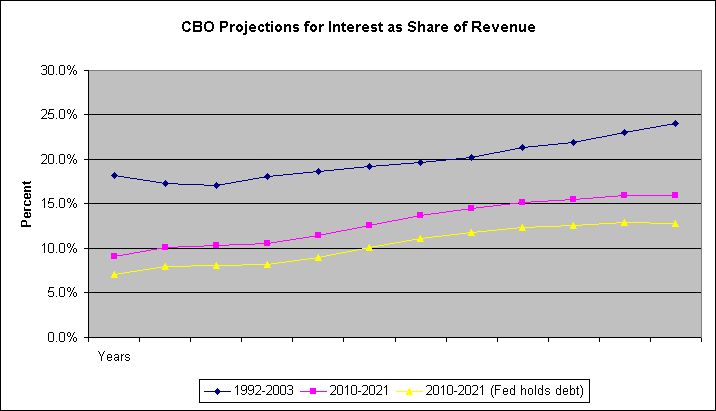April 20, 2011
I finally got a break from laughing over S&P’s threat of downgrade of U.S. debt. You may remember S&P as the credit rating agency that would rate a security: “structured by cows,” which was said by one of its analysts in reference to S&P’s proclivity for stamping subprime mortgage backed securities with investment grades.
But now S&P is warning us all that we better get very concerned about the budget deficits or else they will downgrade the government’s debt. I have to say that this is hard to take seriously from almost every angle.
First, what does it mean that the U.S. government’s credit rating is impaired? We borrow in dollars. Guess who makes dollars?
Imagine if I printed up IOU’s that were payable with my IOU’s. Would S&P think that I might default? This makes no sense. Countries that borrow in a currency they issue will not default unless we get an absurd situation where politicians try to make a point by forcing a default (as in not raising the debt ceiling). It will not happen as a result of budget finances.
There is a potential issue about inflation and higher future interest rates (and therefore lower bond prices). However, if this is the event that S&P is warning against, then the warning should have been applied to all debt that is denominated in dollars, both public and private. If inflation erodes the real value of U.S. government debt, it will also erode the real value of the dollar denominated debt issued by Goldman Sachs and General Electric.
Are these two companies now on the watch list for downgrades along with the rest of corporate America? I don’t think so.
A friend sent over a Moody’s publication on how they gage sovereign default risk. It actually was quite interesting. First of all, their key variable is the ratio of interest payments to revenue.
This must have the tax and spend crowd partying in the street. Suppose that we raise the amount of revenue we take in by 1 percent of GDP (roughly $150 billion a year). If we use Moody’s 18 percent interest to revenue warning line, this additional tax revenue will allow us to accumulate an amount of debt equal to 3.6 percentage points of GDP ($540 billion) before enter the trouble zone.
By contrast, cutting $150 billion in annual spending doesn’t buy us anything in terms of raising the amount of debt that we can safely hold. So the Moody’s story is pretty clear: deal with your deficits by raising taxes rather than cutting spending, if the point is to preserve that golden Aaa rating.
The other item that is striking in this picture is that we have been here before and then some back during the Bush presidency. The ratio of interest to revenue peaked at 18.2 percent in 1992. After falling back slightly with the recovery, the Congressional Budget Office (CBO) projected (Table 4-1) that it would cross 20 percent by 2000 and would exceed 24 percent by the end of projection period in 2003.
By comparison, the current projections look very mild. In the CBO baseline (Table 1-4) the interest to revenue ratio would be just 16.0 percent in 2021. Arguably the baseline is an overly optimistic budget picture, but the budget story would have to turn far more negative to come close to the projections that CBO made in January of 1993.

Source: CBO 1993 and 2011 and author’s calculations.
The question that we have to ask is, “where were the warnings of debt downgrades during the first Bush presidency?”
The other question for the fun-seeking among us, is what happens to this picture if the Fed decides to buy and hold an amount of debt equal to 20 percent of GDP ($3 trillion). The Fed is pretty much there now with its quantitative easing (QE) policy. The difference between this policy and the current baseline is that the Fed is expected to sell off most of the assets it has acquired under it QE policy.
However suppose instead that it continued to hold them over the next decade. The Fed could raise reserve requirements to offset the impact that this action would have on the money supply, thereby preventing inflation. If the Fed continued to hold this debt, then the interest paid on this debt would be refunded right back to the Treasury, creating no net interest burden for the government.
If Moody’s definition of net interest meant interest actually paid out by the government, then our CBO baseline would look even more benign after being adjusted in this manner as shown above. In this case, the ratio of interest payments to revenue stays under 13 percent over the 10-year projection period. It is hard to see any good reason why the buy and hold policy would not be on the agenda – except of course that it is likely to reduce bank profits.
Of course this whole discussion of the federal government defaulting is just silly – presumably it is designed to push political ends. It is hard to believe that there is not more outrage over being lectured on responsible fiscal policy by the bond-rating agencies whose irresponsibility contributed so much to this crisis in the first place.
There would not be 25 million people unemployed, underemployed, or out of the workforce altogether if the bond rating agencies had actually used some judgment in rating the securities issued by the Wall Street investment banks. We would also have much lower budget deficits.






